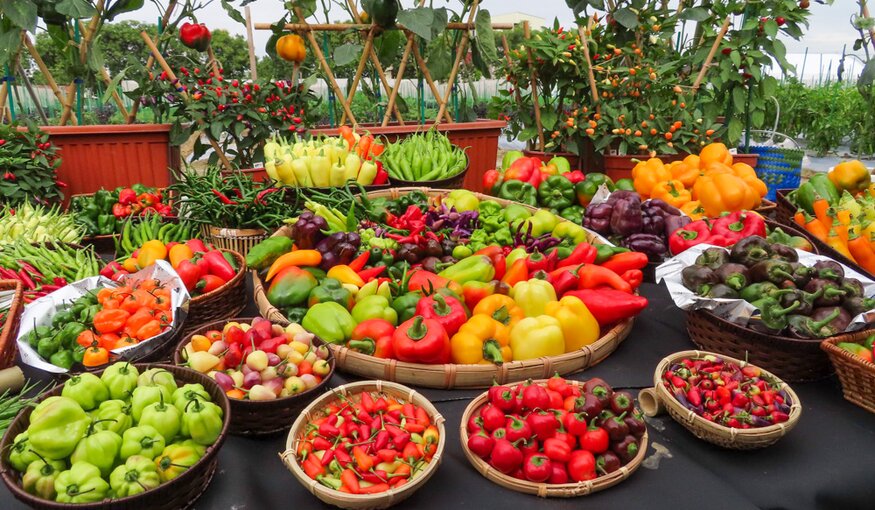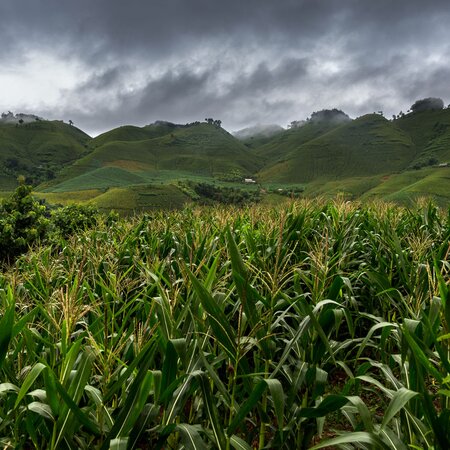Spicing Up Diets and Livelihoods with Peppers

20 June 2023
What behaves like a chameleon, comes in 50 shades of red, green, orange, yellow and even purple, and gets sweeter with age?
It may sound like a creature from a fairy tale, but the real world of plants has an answer all of its own: the chilli pepper.
This spicy mainstay of human diets—originating in South America about 10,000 years ago—comes in a kaleidoscope of colors, and it has lots of different shapes and sizes too.
It also delivers healthy doses of provitamin A, vitamins C and E as well as vital minerals and antioxidants.
While chilli peppers are a great way to add some zing to a diet, they are also a high-value crop that provides livelihoods to many smallholder farmers and are a hotly traded commodity around the world.
Over the past 60 years, there have been increases in both harvested area and tonnage for both fresh and dry chili peppers around the world, especially in Asia, where more than two-thirds of production now occurs.
Actually, there are five domesticated and widely cultivated species of peppers, and they’re not all hot, each with many varieties, plus many wild relatives. This diversity helps ensure that breeders can continue to produce improved crop varieties that can withstand harsh climates, diseases and pests, and farmers can continue to spice up the world’s food.
Under Threat
Yet this wild and cultivated diversity is under threat from the effects of a warming planet and socioeconomic changes around the world. Some diversity is conserved by international and national genebanks, universities, botanic gardens, and seed savers. But we don’t know how well they are doing, and what’s missing from such collections.
To gain an overview on the current state of the conservation and use of pepper genetic resources, the Crop Trust therefore commissioned a Global Strategy for the Conservation and Use of Capsicum Genetic Resources, led by experts at the World Vegetable Center and the San Diego Botanic Garden.
The work is part of a series of strategies facilitated by the Crop Trust to promote the conservation and use of the genetic diversity of different crops.
A key goal of the strategy is to identify gaps in genebank collections, so that the full range of diversity is available to future generations.
“This strategy compiles all of the work that has been done in the past into a single document, allowing us to avoid any repetition or duplication of efforts, while conserving and collecting peppers in a more strategic and efficient way,” says Derek Barchenger, a pepper breeder at the World Vegetable Center, and one of the strategy’s authors.
Alarm Bells
As is often the case with crops in genebanks, the wild species were extremely poorly represented among the 50,000 or so samples of pepper seeds conserved around the world, according to the authors.
“We risk losing a lot of wild pepper diversity,” Barchenger says. “It seems like time is running out to make a serious effort to protect them.”
Seeds don’t live forever, and at regular intervals genebanks will plant their holdings to produce fresh samples for storage. This is called regeneration. While the number of conserved pepper samples may sound like a lot, the strategy’s authors found that almost 40 percent of them, on average, presently require urgent regeneration.
Global databases also indicated that only 18 to 37 percent of pepper samples are safety duplicated, depending on the genebank.
This means that many seed samples have not been backed up in another genebank—ideally in another country—and in the Svalbard Global Seed Vault, which holds over 6,000 pepper seed samples, or only an estimated 13 percent of the global collection.
“What we now need to do is to bring the strategy to life,” Barchenger says. “We need to collect, regenerate, safety-duplicate, and fast.”
It’s the only way that future generations will continue to enjoy peperonata, chilli con carne, Tabasco sauce and hu pi jian jiao.
Categories: Global Crop Conservation Strategies, Chili
About the Global Crop Conservation Strategy project
The development of this Global Crop Conservation Strategy was funded by the German Federal Ministry of Food and Agriculture (BMEL) as part of a three-year project led by the Crop Trust: “Breathing New Life into the Global Crop Conservation Strategies: Providing an Evidence Base for the Global System of Ex situ Conservation of Crop Diversity.”

